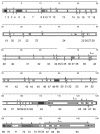The Genomic Characterization of Equid Alphaherpesviruses: Structure, Function, and Genetic Similarity
- PMID: 40266963
- PMCID: PMC11945689
- DOI: 10.3390/vetsci12030228
The Genomic Characterization of Equid Alphaherpesviruses: Structure, Function, and Genetic Similarity
Abstract
Equine herpesvirus 1 (EHV-1), EHV-4, EHV-8, and EHV-9, are classified within the subfamily Alphaherpesvirinae and are recognized as causative agents of respiratory, urogenital, and neurological disorders in horses. These viruses, collectively referred to as αEHVs, exhibits both unique and shared characteristics in terms of host interaction, pathogenesis, epidemiology, and immune evasion, which arise from both the identities and discrepancies among respective genomic homologs. The genomic architecture of αEHVs is similar to other members of the same subfamily, such as well-known HSV-1, VZV, and PRV. However, research on the molecular mechanisms underlying αEHV infection and immune response remains significantly less advanced compared to studies on human, porcine, and bovine herpesviruses. This paper systematically describes the genomic structure, function, and genetic similarities of αEHVs and conducts a comparative analysis of selected αEHVs through pairwise sequence alignments of nucleotides and amino acids. This review offers an extensive synthesis of the current understanding related to the study of αEHVs, highlighting the challenges and potential solutions for future research endeavors.
Keywords: comparative analysis; equid alphaherpesvirus; function; future research; genomic structure.
Conflict of interest statement
The authors declare no conflicts of interest.
Figures

Similar articles
-
Pathogenic potential of equine alphaherpesviruses: the importance of the mononuclear cell compartment in disease outcome.Vet Microbiol. 2010 Jun 16;143(1):21-8. doi: 10.1016/j.vetmic.2010.02.010. Epub 2010 Feb 11. Vet Microbiol. 2010. PMID: 20202764
-
Comprehensive Analysis of Equid Herpesvirus Recombination: An Insight Into the Repeat Regions.J Equine Vet Sci. 2023 Nov;130:104916. doi: 10.1016/j.jevs.2023.104916. Epub 2023 Sep 11. J Equine Vet Sci. 2023. PMID: 37704182
-
Equine herpesvirus type 1 unique short fragment encodes glycoproteins with homology to herpes simplex virus type 1 gD, gI and gE.J Gen Virol. 1990 Dec;71 ( Pt 12):2969-78. doi: 10.1099/0022-1317-71-12-2969. J Gen Virol. 1990. PMID: 2177089
-
Antiviral agents against equid alphaherpesviruses: Current status and perspectives.Vet J. 2016 Jan;207:38-44. doi: 10.1016/j.tvjl.2015.06.010. Epub 2015 Jun 12. Vet J. 2016. PMID: 26654843 Review.
-
Equine herpesviruses type 1 (EHV-1) and 4 (EHV-4)--masters of co-evolution and a constant threat to equids and beyond.Vet Microbiol. 2013 Nov 29;167(1-2):123-34. doi: 10.1016/j.vetmic.2013.06.018. Epub 2013 Jul 6. Vet Microbiol. 2013. PMID: 23890672 Review.
References
-
- Pellett P.E., Davison A.J., Eberle R., Ehlers B., Hayward G.S., Lacoste V., Minson A.C., Nicholas J., Roizman B., Studdert M.J., et al. Order-Herpesvirales. In: King A.M.Q., Adams M.J., Carstens E.B., Lefkowitz E.J., editors. Virus Taxonomy: Classification and Nomenclature of Viruses: Ninth Report of the International Committee on Taxonomy of Viruses. Elsevier; San Diego, CA, USA: 2012. pp. 99–107.
Publication types
LinkOut - more resources
Full Text Sources

